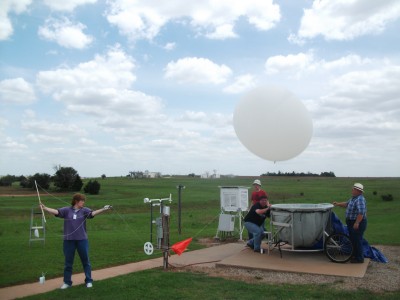Editor’s note: Mike Jensen, a scientist at Brookhaven National Laboratory, sent this update. He led the Midlatitude Continental Convective Clouds Experiment, or MC3E, and is part of the translator team that creates data products from ARM measurements.

Each year, the ARM Climate Research Facility launches thousands of weather balloons—radiosondes attached to helium balloons—to obtain critical measurements of temperature, pressure, humidity, and winds from the surface to well into the stratosphere. Recently, Vaisala, the company that designs and manufactures the radiosondes that ARM uses, released a new generation of radiosonde systems. These new radiosondes promise simpler launch preparation procedures and improved accuracy of temperature and humidity measurements.
Over the course of 5 days in early June at the ARM Southern Great Plains (SGP) site in Oklahoma, I joined scientist Donna Holdridge from Argonne National Laboratory and Vaisala engineer Petteri Survo to perform a series of weather balloon launches designed to test and evaluate the latest technology in radiosonde instrumentation. In order to perform direct comparisons, each balloon included special rigging to hold both the current and new generation of radiosondes so they could be launched together. This extra rigging required the use of balloons nearly twice as large as those used for normal operations and a small parachute to slow the fall of the rigging after the balloon bursts.
With help from SGP site operations staff, we completed a total of 20 balloon launches—14 during the day and 6 at night—under a variety of cloud conditions, from nearly clear to overcast. We avoided launching when storm clouds threatened.
Assisted by Shannon Baxter, a student intern at Brookhaven, my next step is to compare and analyze the performance of the two radiosonde types. Our initial analysis shows excellent agreement between the different radiosondes, with some apparent improvements in measurements under cloudy conditions for the new generation radiosondes. After our analysis, we’ll prepare a report to document the comparison. The results of the comparison will help the ARM Facility make decisions about switching to the new radiosondes.

